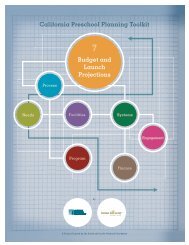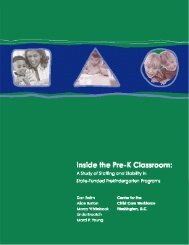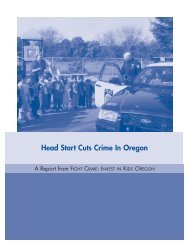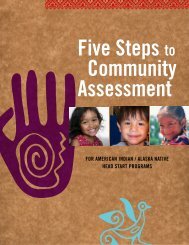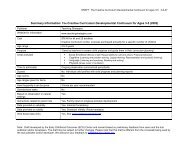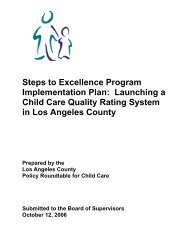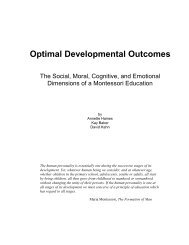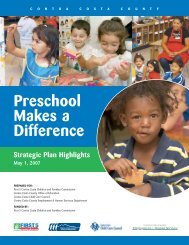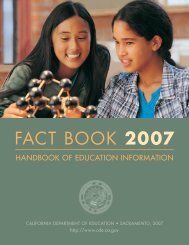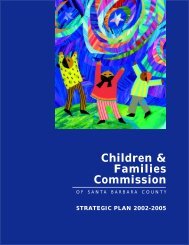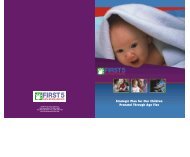Mapping the P-3 Continuum - Foundation for Child Development
Mapping the P-3 Continuum - Foundation for Child Development
Mapping the P-3 Continuum - Foundation for Child Development
Create successful ePaper yourself
Turn your PDF publications into a flip-book with our unique Google optimized e-Paper software.
EXECUTIVE SUMMARYCurrent education policy in <strong>the</strong> United States, which emphasizes high stakes testing of children,is unfair to many who do not experience an adequate education. Many children enterkindergarten on unequal footing due to variability in pre-kindergarten experiences, and, oncechildren enter kindergarten, variations in education content and quality. This variability in prekindergartenexperiences and subsequent schooling is a strong predictor of children’sachievement outcomes. These effects are even stronger <strong>for</strong> low-income children. A P-3approach aims to level <strong>the</strong> academic playing field <strong>for</strong> all children by supporting ef<strong>for</strong>ts to alignpre-kindergarten through third grade by re<strong>for</strong>ming teacher preparation and certification anddeveloping sequential learning experiences <strong>for</strong> children as <strong>the</strong>y move from pre-kindergartenthrough Grade 3.The <strong>Foundation</strong> <strong>for</strong> <strong>Child</strong> <strong>Development</strong> convened stakeholders to discuss next steps <strong>for</strong> movinga P-3 agenda <strong>for</strong>ward. A list of participants is appended to this summary. Directions <strong>for</strong> nextsteps included:1. Crafting a working definition of P-3. The definition <strong>for</strong> P-3 must include voluntary universalpre-kindergarten <strong>for</strong> children, full-day kindergarten, and alignment of both through <strong>the</strong> thirdgrade of elementary education. P-3 can be an alignment of grade levels based on developmentaland learning characteristics of children as <strong>the</strong>y proceed from pre-kindergarten through thirdgrade and including <strong>the</strong>ir after-school experiences.2. Identifying and documenting specific examples of P-3 and <strong>the</strong>ir effects on children’s learning.Examples of P-3 exist, and can in<strong>for</strong>m how to expand on current ef<strong>for</strong>ts or start up new ones.3. Addressing financing and governance issues, which include targeting sources of funds, anddeveloping plans <strong>for</strong> governance structures. One example of a well-per<strong>for</strong>ming governancestructure is that of Chicago’s <strong>Child</strong>-Parent Centers, where <strong>the</strong> program is implemented withinone administrative system, <strong>the</strong> Chicago public school system. Financing ideas can come fromplaces already implementing parts of a P-3 agenda, like Cali<strong>for</strong>nia, Georgia, and New Mexico.4. Addressing <strong>the</strong> recruitment, preparation, professional development, and retention of teachers.Participants agreed that current teacher education and credentialing are not adequately preparingteachers <strong>for</strong> <strong>the</strong> classroom.5. Identifying key leverage points. Many stakeholders, who serve different and/or overlappingconstituencies, were identified at <strong>the</strong> meeting. Engaging <strong>the</strong>se stakeholders as well as colleaguefunders will be necessary to build consensus and move <strong>the</strong> P-3 agenda <strong>for</strong>ward.6. Marketing <strong>the</strong> P-3 message. Attention must be paid to <strong>the</strong> content of <strong>the</strong> message, as well asspecific authoritative messengers. Issues raised by stakeholders who will oppose <strong>the</strong> initiativeshould be addressed. Careful attention to language and rhetoric when delivering messages willbe crucial to <strong>the</strong> effectiveness of P-3.INTRODUCTION3



